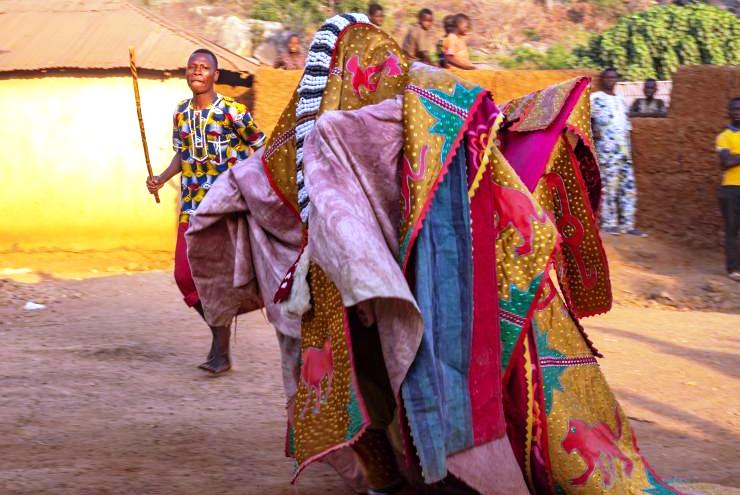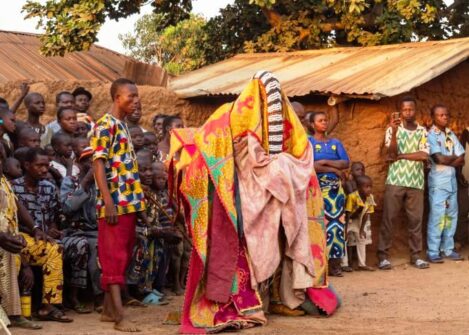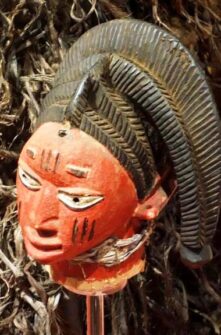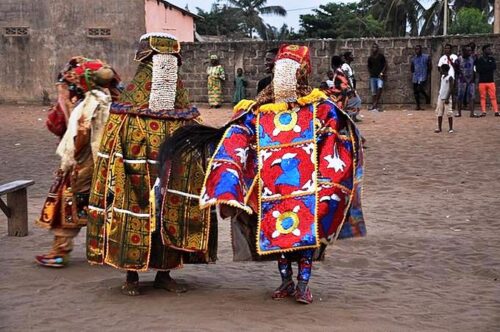Nigeria. The Egungun Cult among the Yoruba People.

The Yoruba people are one of the largest in West Africa; they live in southern Nigeria and Benin. They have developed a refined culture, at the centre of which is a religious world rich in symbols, mythologies, and ceremonies.
One of the most characteristic aspects of the Yoruba religion is the masks. One of these is Egungun. Literally, the word Egungun can be translated as ‘living dead’, or, in its variant ‘ara orun, as ‘inhabitants of the sky’. In the broadest sense, it designates a masked figure wearing a costume, a disguise for ancestor worship. For Yoruba all over the world, the Egungun cult represents the communion between the living and the ancestors. They celebrate the visit of ancestral spirits to their descendants to bless them, encourage them to persevere in cultural values and, when necessary, judge the living.

The resplendent colours of the Egungun. 123rf.
The cultic function, in fact, is above all that of solving the problems of the community; this sacred dimension explains why the Egungun is a secret society, the basis of which is the law of silence.
There are different types of Egungun masks.
The Omo Egungun, ‘son of Egungun’ or ‘young Egungun’, has costumes made with variegated and ornate bands of fabric, which whirl in a slow and majestic dance.
The Agba Egungun, ‘senior Egungun’, on the other hand, have costumes made of dirty rags and masses of clay with animal skulls encrusted with shells.Traditionally, the Egungun mask is reserved for men, assisted only by a woman named Iya Agan, the priestess of the cult deity. She symbolizes the bond between gods and ancestors.

Mask Yoruba Egungun – Glenbow Museum. Calgary, Canada.
According to tradition, women should not know the identity of the wearer and it is dangerous for them to touch them. Some Agba Egungun are said to be able to identify witches, who in Yoruba culture are almost always women.
The Egungun masquerade is a multi-faceted ceremony, which includes the presentation of offerings and honouring ancestors for their life of virtue. During the ceremony, the living implores their help for peace and harmony in the community. For the Yoruba, ancestors are heavenly promoters, capable of crossing the line that separates the world of the dead from that of the living. Among the wide range of themes associated with Egungun’s masquerade, there is the correction of social and cultural stereotypes.
In the Yoruba social organization, the appearance of the mask is periodic, to celebrate and invoke the dead. This period is known as the Egungun festival, which lasts about a week.
However, communities can decide on the release of the mask during clan ceremonies from birth to death. Thus, it is customary for an Egungun to come out of the dead man’s chamber sometime after the burial and imitate him as he brings the greetings of the dead to the other members of the family. In this cult, the costumes must be beautiful to communicate an impression of vigour and prosperity. An Egungun costume is made up of several layers of strips of cloth made with expensive and prestigious fabrics which express the wealth and status of a family, as well as the power of the ancestor.To make the costume more beautiful, and therefore powerful, the strips are decorated with motifs of patchwork, braids, sequins, pompoms, and amulets.

Egungun displaying during a festival. CC BY 4.0/Aborisadeadetona
Although they differ from region to region, they must completely hide the identity of the wearer. The mesh effectively hides the facial and hand features that could reveal the wearer.
The costume is repaired and renewed for use year after year, with layers of new strips and amulets added to express memory and honour.
The other function of worship is to entertain. The Egungun festival is also a festive time similar to the carnival. During these popular outings, the Egungun dance around the city to amuse the public.
They are accompanied by supporters, holding whips to ward off people who try to get too close. Other members of the community and followers of other beliefs, including Christians and Muslims, also dance to the rhythm of the Egungun. Today, Egungun festivals are organized not only by the Yoruba communities of West Africa but also in America and the Caribbean. (Open Photo: Ceremonial mask dance, Egungun. 123rf.)
Silvia C. Turrin/SMA



